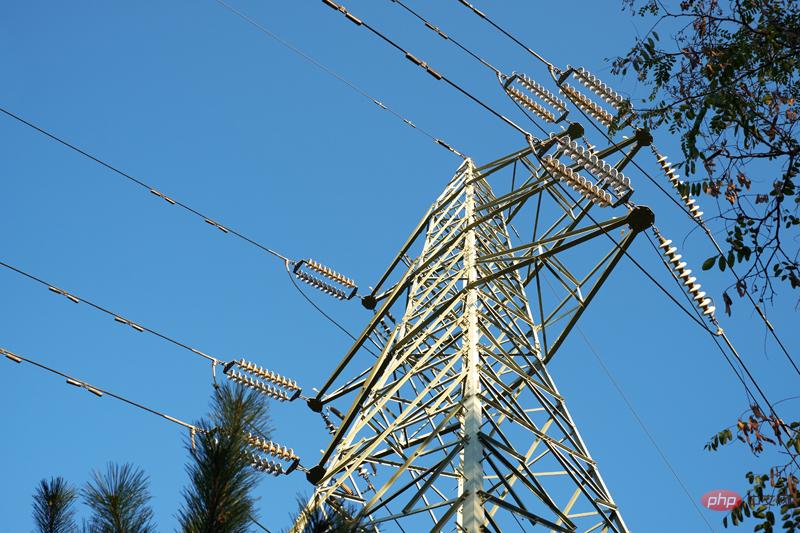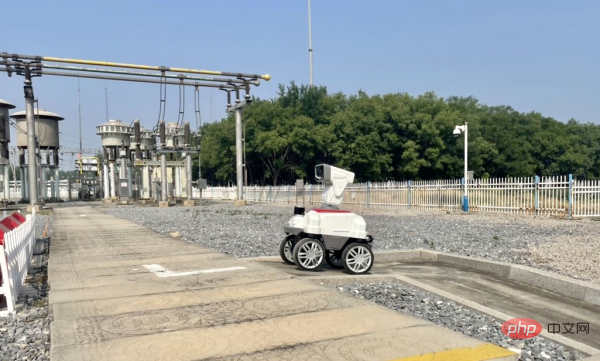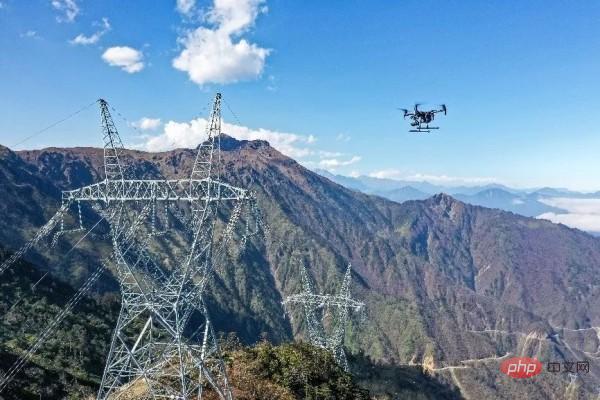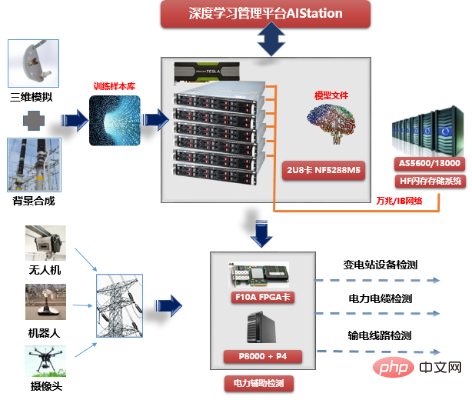 Technology peripherals
Technology peripherals
 AI
AI
 Breaking the boundaries of power inspection requires these new technologies
Breaking the boundaries of power inspection requires these new technologies
Breaking the boundaries of power inspection requires these new technologies
A drone shuttles between power lines and towers, taking high-precision photos of transmission lines. The photos taken are compressed at a high magnification using algorithms, and combined with the towers through the wireless communication capabilities of the drone. The composite optical fiber overhead ground wire is quickly transmitted to the back-end computer room equipment. After decompression, the restored picture is almost the same as the original picture taken. The picture is analyzed through artificial intelligence, and diagnostic results are quickly generated and sent to the staff. This power inspection model is not only more efficient, but also avoids various safety hazards during manual inspections. This has also become a goal that many countries are striving to achieve in the digital transformation of the power industry.
In the past, in order to ensure the stable operation of power lines and power systems, power supply companies needed to regularly arrange inspection personnel to inspect lines and equipment and discover hidden dangers. However, power inspection has always been a dangerous job. For inspection personnel, not only must it be accurate, but they also need to work in two shifts, which is time-consuming and labor-intensive. Some facilities even require climbing and "steel walking". So”. For power supply companies, since this job is very hard, the cost of employment is naturally not low.
Traditional power inspection - low efficiency and high risk
Now most power cable tunnels, substations, transmission lines, switching stations and other facilities mainly use It is also an inspection method involving manual labor and a small number of environmental monitors.
Traditional power line inspection methods mainly include special marking methods, bar code identification methods and information button collection methods. The special marking method requires marking on the power line tower in advance, and inspection personnel use these marks to confirm the status of the pole. The disadvantage is that it is easily affected by human factors; the barcode identification method also requires affixing a barcode on the pole in advance, and accessing the barcode information To complete the power line inspection, although it is easier to operate than the special marking method, the barcode is easy to be destroyed, and it does not completely get rid of manual management, affecting the accuracy; the information button collection method, by installing information buttons with different numbers, the inspection personnel use handheld The equipment scans the information buttons, accesses and transmits data, and completes the analysis and processing of power line information. However, the installation of the information buttons is more complicated, and the inspection process also requires on-site operations by staff, making it difficult to achieve comprehensive line management.

The traditional line inspection model is not only inefficient but also comes with high risks. It requires workers to climb up the transmission line and "walk the tightrope". In some remote places, it is necessary to climb mountains and ridges to inspect. Due to the condition of equipment and lines, one person can usually only complete the inspection of 2 to 3 towers a day. According to data from the National Energy Administration, a total of 29 accidents occurred in the country in the first three quarters of 2021, with a total of 34 deaths. It can be seen that traditional inspection work is not only inefficient, but also dangerous.
In addition, under the traditional power inspection model, the sense of responsibility, professional ability, work experience and other characteristics of each staff member are also uneven. These factors will also affect the quality and duration of the inspection. For managers, it is difficult to accurately evaluate the work quality of inspection personnel by relying solely on inspection records, resulting in many inspections becoming a mere formality.
Robot - the first step in the digitalization of power inspection
Currently, the domestic power industry is actively responding to the construction of the digital economy and Digital China and carrying out digital transformation. Combining intelligent monitoring equipment with digital management systems will significantly reduce the workload of daily inspections, effectively improve the quality of inspections, and improve management efficiency.
In July this year, at the 5th Digital China Construction Summit, Alibaba demonstrated a "robot electrician" that can automatically inspect the power distribution room after setting a route through the Alibaba Cloud navigation algorithm and use cameras to and the infrared sensor detected a fault. In September of the same year, State Grid Intelligence also launched development cooperation with Alibaba Cloud in the field of navigation systems. The first round focused on wheeled inspection robot products. The autonomous driving positioning and navigation technology of Alibaba DAMO Academy can help optimize the environment of power inspection robots. Perception, map construction and path planning capabilities enable wheeled inspection robots to escape difficulties and recharge independently, improving the stability and intelligence of the robot.

Wheeled robot in substation
This wheeled robot can complete outdoor tasks Centimeter-level high-precision mapping of large scenes, the positioning initialization success rate at any location on the map reaches 98%, and the use of low-cost multi-sensor fusion positioning can achieve "centimeter-level" positioning accuracy and obstacle recognition. The real-time terrain estimation function that integrates multi-sensor observations can complete path planning and select safe routes online to help the robot operate stably in complex terrain conditions.
At this stage, wheeled robots are increasingly involved in power inspection work. They can completely get rid of traditional fixed tracks. However, in the face of complex terrain environments, wheeled robots are difficult to complete this work. In comparison, quadruped robots that can walk on mountain roads and go up and down stairs are much more flexible.

Boston Dynamics Spot quadruped robot
Quadruped robot is also currently being tried Participate in power inspection work, the most famous of which is Spot, which is already sold by Boston Dynamics. Domestic robot manufacturers are also exploring the application scenarios of quadruped robots. For example, Shanghai Power Cable Company is trying to use Jueying Deep in the Cloud to conduct line inspection tests. Although there is still some room for development in quadruped robot technology, whether they are wheeled or quadruped robots, they can provide good ground support for power distribution rooms, substations and other facilities.
These are not the only facilities that need to be inspected in the power industry. Pole towers located in cities, villages, and even mountainous areas require more flexible inspection equipment due to their remote locations and complex environments. UAV-based inspections Inspection mode is gradually being adopted.
Drones - the digital "wings" of power inspections
In mountainous areas, power inspections need to face extreme climate and complex terrain problems at any time. For example, in In the plateau area of Sichuan Province, many of the transmission lines operated and maintained by Sichuan Power Transmission and Transformation Company are built on steep cliffs. Most of the towers are over 3,000 meters above sea level. In high-altitude environments, the thin air will cause the lift to be significantly reduced. Drones need to consume more power to maintain their flight altitude, which affects battery life.
DJI has adapted the Inspire 2 with plateau paddles, which can ensure stable flight at an altitude of 5,000 meters, and can also carry out normal power inspection operations in the Sichuan plateau mountainous areas. In addition, the DJI Phantom 4 and Mavic 2 series drones are equipped with universal propellers, which can also fly safely at an altitude of 6,000 meters without changing the propellers according to the altitude.

DJI drone flying in high altitude areas
For long endurance According to the demand, the DJI Matrice 200 V2 series is equipped with a high-capacity TB55 battery, which reserves 15 to 20% of the landing power. Only the Zenmuse X5S or Zenmuse Z30 single gimbal load is installed. The Matrice 200 V2 series has a battery life of power inspection in plateau mountainous areas. It can last up to 22 to 27 minutes and can better adapt to the harsh flight environment at high altitudes.
Although the combined use of drones, robots and cameras can significantly reduce the labor cost of power inspections, due to size limitations, these devices often only have functions such as high-precision photography and automatic navigation. Strictly speaking, taking photos and sending them back is only half of the inspection work. Making the other half of the work smart requires upgrading back-end facilities.
Artificial intelligence - the "most powerful brain" of power inspection
The pictures captured by the equipment during the inspection can be quickly transmitted to the back-end equipment through the 5G network , combined with artificial intelligence, can automatically complete the analysis of pictures.
Inspur’s “Artificial Intelligence Solution for Power Equipment Inspection” works exactly like this. It uses artificial intelligence technology to identify and analyze on-site power equipment pictures, complete sample data preparation, model training, and model application. The pictures collected by drones, robots and other equipment are transmitted to the detection server deployed in the power station studio for identification, and intelligent diagnosis is quickly completed.

Similar combinations have also been adopted by power supply companies in some areas. State Grid Ningbo Power Supply Company and China Mobile jointly developed a 5G drone autonomous inspection application. The drone can fly from the nest to the inspection point according to the established route, and uses its own high-definition camera to capture detailed shots of insulators and towers. Details such as ground wires are transmitted back in real time through the 5G network. Once a safety hazard is identified, the drone will automatically trigger the processing mechanism to eliminate the hazard as soon as possible. After completing the task, it will automatically and accurately land back to the nest.
State Grid Shandong Electric Power Company Qingdao Power Supply Company has also independently developed a "5G Beidou-based drone intelligent inspection system" and built a 5G SA power slicing network data high-speed and safe transmission system, combined with artificial intelligence based on deep learning algorithms The intelligent diagnosis and analysis platform can realize autonomous drone inspections, real-time data transmission, and intelligent defect analysis. It is the first in China to form a precise and intelligent drone inspection method based on the Beidou system.
Written at the end
With the support of new technologies, power inspection work has become more efficient. Public information shows that after the Shenzhen Power Supply Bureau adopted autonomous drone inspections, the efficiency increased by 2.6 times compared with traditional manual inspections; Foshan Gaoming Power Supply Bureau also achieved full coverage of autonomous drone inspections and built 385 smart power rooms.
In the future, as the penetration rate of power inspection robots and drones increases, the probability of accidents in my country's power industry will also decrease, and the inherent high-risk industry characteristics of power operations and inspections are also expected to change. Power inspection using robots and drones combined with new technologies such as 5G and artificial intelligence is also an important means of realizing the development of intelligent and automated power grids.
The above is the detailed content of Breaking the boundaries of power inspection requires these new technologies. For more information, please follow other related articles on the PHP Chinese website!

Hot AI Tools

Undresser.AI Undress
AI-powered app for creating realistic nude photos

AI Clothes Remover
Online AI tool for removing clothes from photos.

Undress AI Tool
Undress images for free

Clothoff.io
AI clothes remover

AI Hentai Generator
Generate AI Hentai for free.

Hot Article

Hot Tools

Notepad++7.3.1
Easy-to-use and free code editor

SublimeText3 Chinese version
Chinese version, very easy to use

Zend Studio 13.0.1
Powerful PHP integrated development environment

Dreamweaver CS6
Visual web development tools

SublimeText3 Mac version
God-level code editing software (SublimeText3)

Hot Topics
 1378
1378
 52
52
 2024 DJI drone rankings: Each model has sales of 50,000+, which one have you used?
Dec 16, 2023 pm 05:33 PM
2024 DJI drone rankings: Each model has sales of 50,000+, which one have you used?
Dec 16, 2023 pm 05:33 PM
Hello, hello! I am Yuan Haha, please pay attention, more exciting content is waiting for you. With the continuous advancement of drone technology, we can now buy one of the most important and reliable 4K cameras within a budget of several thousand yuan. This is how many times Unimaginable years ago. With the continuous efforts of DJI, Autel and other companies, this dream has become a reality. The overall drone of choice is DJI Mavic 3 Pro. This drone not only provides ultra-high definition recording, but also has excellent frame rates and long-lasting battery. life. In addition to my personal experience, I’ve compiled some other top drones for you to choose from based on positive reviews around the web. Now, let’s take a look at these exciting options. Best Drone Overall: DJIMavic 3Pr
 Drone swarms: A game-changing technology for defense applications
Nov 14, 2023 pm 08:53 PM
Drone swarms: A game-changing technology for defense applications
Nov 14, 2023 pm 08:53 PM
Abstract: Swarming is a disruptive, game-changing technology that involves the collaborative deployment of multiple unmanned systems in multiple domains (land, sea, air, space). Developments in new microelectronics, guidance, navigation, sensors and artificial intelligence technologies enable low-cost micro-drones to perform challenging missions. When combined with novel decision-making processes, target tracking, communications technologies and algorithms, swarms can have a huge impact on the battlefield. It can also be used to provide continuous and undetectable surveillance capabilities as well as critical defense capabilities, such as intercepting cruise missiles. This article describes European research activities in the field of swarming and delves into the significant implications it may have for defence. Keywords: UAV, autonomous capability, target tracking,
 The largest domestically produced unmanned transport aircraft successfully made its maiden flight: equipped with China Aviation Engineering Group's AEP100-A engine
Aug 23, 2024 am 07:32 AM
The largest domestically produced unmanned transport aircraft successfully made its maiden flight: equipped with China Aviation Engineering Group's AEP100-A engine
Aug 23, 2024 am 07:32 AM
According to news from this website on August 22, China Aviation Engine Group Co., Ltd. issued an official announcement today. At 6:28 today, the 900-kilowatt turboprop engine AEP100-A, which was completely independently developed by China Aviation Industry Corporation, powered the SA750U large unmanned transport aircraft in Shaanxi. Successful first flight. According to reports, the AEP100-A turboprop engine was designed by the China Aerospace Engineering Research Institute and manufactured in the South. It has the ability to adapt to high temperatures and plateaus. It uses three-dimensional aerodynamic design and unit design technology to provide power for aircraft while improving fuel economy. Improve overall aircraft operating efficiency. The AEP100 turboprop engine series can be equipped with 2 to 6 ton general-purpose aircraft or 3 to 10 ton unmanned aerial vehicles, and its comprehensive performance has reached the international advanced level of the same level currently in service. This site reported earlier
 my country's first large-scale unmanned transport aircraft with a load exceeding 3 tons, the 'SA750U', successfully made its maiden flight, with nationally produced systems and materials
Aug 23, 2024 am 07:31 AM
my country's first large-scale unmanned transport aircraft with a load exceeding 3 tons, the 'SA750U', successfully made its maiden flight, with nationally produced systems and materials
Aug 23, 2024 am 07:31 AM
According to news from this site on August 22, according to the official public account of "Shanhe Huayu", at 6:28 today, the SA750U large unmanned transport aircraft independently developed by Sunward Huayu Aviation Technology and completed by the strategic coordination of Sunward Star Airlines flew from Jingbian, Xi'an. The experimental drone test center successfully made its first flight. ▲Picture source "Shanhe Huayu" official public account, the same as below. According to reports, during the 40-minute flight test, all system equipment of the aircraft worked normally and were in good condition. The attitude of the aircraft was stable and the performance met the design specifications. After completing the scheduled flight subjects Afterwards, the plane returned smoothly and the first flight was a complete success. The SA750U is my country's first large-scale unmanned transport aircraft with a load of over 3 tons. It only took Shanhe Huayu Company 2 years and 8 months to complete the entire process from concept design to the successful first flight of the first aircraft.
 The Wing Loong UAV takes to the skies again and becomes an aerial base station in Gansu
Dec 21, 2023 am 08:13 AM
The Wing Loong UAV takes to the skies again and becomes an aerial base station in Gansu
Dec 21, 2023 am 08:13 AM
The Wing Loong-2H drone once again went to Jishishan County, Gansu Province to perform disaster relief tasks such as disaster reconnaissance and emergency communication support. This type of drone is called an "air base station" and can continuously restore public network signal networks of China Mobile, China Unicom, and Telecom, directionally restore 50 square kilometers of public network communications, and establish an audio and video communication network covering 15,000 square kilometers. The Wing Loong-2H performed well in the 2021 heavy rain disaster rescue in Zhengzhou, Henan, and the 2022 Luding earthquake rescue in Sichuan, successfully completing the mission. Original source: CCTV Military Weibo
 Domestic Wing Loong series drones: writing a new chapter in multi-field applications, covering many fields such as meteorology, emergency, and security
Dec 01, 2023 pm 05:47 PM
Domestic Wing Loong series drones: writing a new chapter in multi-field applications, covering many fields such as meteorology, emergency, and security
Dec 01, 2023 pm 05:47 PM
According to Science and Technology Daily, on November 28, at the AVIC UAV site in Zigong, Sichuan, the Aviation Industry Corporation of China held an open day event with the theme of "The Winged Dragon of a Great Power Travels the World" to comprehensively display domestically produced large-scale drones. Development achievements in high-end drone development and industrial construction. After more than ten years of development, the domestically produced "Pterosaur" series of UAV products independently developed by AVIC UAV have formed a pedigree. The Wing Loong-2 appeared at the state-owned enterprise's open day and performed a flight demonstration. The Wing Loong-2 is a medium-high altitude, long-endurance multi-purpose UAV system developed by the aviation industry. It has all-day, all-weather, all-territory, and multi-scenario mission execution capabilities. This UAV system is my country's first domestically produced large-scale turboprop-powered UAV system. It has advanced aerodynamic layout, body structure,
 Panasonic will mass-produce all-solid-state batteries for drones, claiming to charge 80% in 3 minutes
Sep 21, 2023 pm 08:21 PM
Panasonic will mass-produce all-solid-state batteries for drones, claiming to charge 80% in 3 minutes
Sep 21, 2023 pm 08:21 PM
Panasonic Holdings announced on September 12 that it plans to start mass production of small all-solid-state batteries currently being developed for applications such as drones in the second half of the 2020s (that is, 2025 to 2029). According to the Nikkei Shimbun, Panasonic Holdings said that if it can be put into practical use, it is expected to be able to charge 80% of the drone battery capacity in about 3 minutes. Compared with existing lithium-ion batteries that take about an hour to charge, convenience will be greatly improved. Panasonic Holdings disclosed its technology demonstration to the media and customer companies for the first time and introduced all-solid-state batteries. Although details such as the composition of the metal material have not been announced, officials say it is expected to be able to charge and discharge tens of thousands of times, which will far exceed the approximately 3,000 times of charge and discharge of ordinary lithium-ion batteries. All-solid-state batteries as a new generation of vehicle battery backup
 Real-time issues in UAV image processing
Oct 08, 2023 pm 04:33 PM
Real-time issues in UAV image processing
Oct 08, 2023 pm 04:33 PM
Real-time issues in UAV image processing require specific code examples. With the continuous development of UAV technology, UAV application fields are becoming more and more extensive. Image processing plays an important role in drone vision applications. However, UAVs face some challenges in real-time image processing, especially when processing large-scale image data. This article will explore how to solve real-time problems in UAV image processing and provide some specific code examples. First, drones face latency issues in image transmission. Because drones usually use wireless



